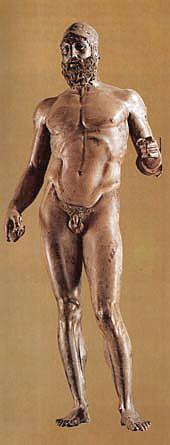 The Magna Graecia Itinerary
The Magna Graecia Itinerary 
 The Magna Graecia Itinerary
The Magna Graecia Itinerary 
This itinerary takes us through the National Museum which because of the vastness of its collections needs a good two hours at the very least.
The Museum stands between Piazza De Nava and Via Vittorio Veneto, quite near the Municipal Lido, near the Lido Railway station and the Excelsior and Palace hotels and not far from the Public Library and the Port of Reggio Calabria.
There is parking space in the nearby Piazza Indipendenza or on Viale Genoese Zerbi between the Piazza and the port. In the area there are a fair number of snack bars and restaurants.
The Museum is open in the winter from nine o'clock in the morning until one o'clock lunch time and from three thirty in the afternoon until until seven. In the Summer from nine in the morning until six thirty in the evening.
On Sundays it opens from nine o'clock until twelve thirty.
On Mondays the museum is open from nine am until one o'clock but every first and third Monday of the month the museum stays closed.
Free entrance for under-eighteen-year-olds and over sixtys. Special arrangements for non-ltalians.


This is considered by the experts to be a true portrait, and because most of them judge it to be from the fifth century B.C.
They also consider it to be the oldest Greek portrait.
It has been carried out with infinite care to capture a perfect likeness, with all the tiniest details of the true facial characteristics at a time when Greek sculptors aimed at portraying people by idealising them rather than really trying to achieve a true likeness.

The two bronzes were found by chance in 1972, on the sea-bed not far from the shore of the lonian seaside town of Riace, about one hundred and twenty kilometres North from Reggio Calabria but the ship which must have been transporting them has never been found.
It is most likely that the two statues were being brought from Greece to Rome on board a ship that foundered in a storm while it was plying the usual sea-route along the coast.
 The two masterpieces which are believed to date from the fifth century before Christ, have become famous the whole world over, both because we have very, very few works of art in bronze made at that time and because of their perfect workmanship.
The two masterpieces which are believed to date from the fifth century before Christ, have become famous the whole world over, both because we have very, very few works of art in bronze made at that time and because of their perfect workmanship.
These two works of art are usually known now as "Statue A", meaning the one that portrays a younger warrior and "statue B" meaning the more mature-looking of the two. The restoration work was first begun in the Reggio Calabria laboratories and continued at the Florence Restoration Centre.
The method used for the fusion of the bronze was that called "cire perdue". There have been many attempts to identify the hand of the artist or artists whose work they are, but the most popular theory is that they were two separate Greek artists who lived about thirty years apart, around the fifth century before Christ.
"Statue A" was probably cast between the years 460 and 450 B.C. and "Statue B" about 430 - 420. Some believe that "Statue A" was the work of Myron and that a pupil of Phydias, called Alkamenes wrought"Statue B".
Statue A portrays a young hero or god, with an ineffable look, conscious of his own beauty and powerfulness.
Statue B, on the other hand is of an older hero with relaxed limbs and a kinder, more gentle gaze.
[Home] [Main Index] [Top]